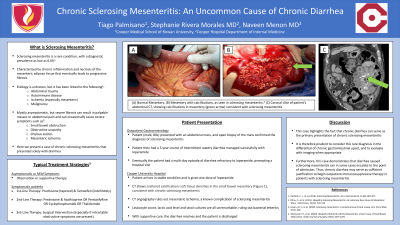Back


Poster Session C - Monday Afternoon
Category: Small Intestine
C0677 - Chronic Sclerosing Mesenteritis: An Uncommon Cause of Chronic Diarrhea
Monday, October 24, 2022
3:00 PM – 5:00 PM ET
Location: Crown Ballroom

Has Audio

Tiago Palmisano, BA
Cooper Medical School of Rowan University
Camden, NJ
Presenting Author(s)
Tiago Palmisano, BA1, Stephanie Rivera Morales, MD2, Naveen Menon, MD2
1Cooper Medical School of Rowan University, Camden, NJ; 2Cooper University Hospital, Camden, NJ
Introduction: Sclerosing mesenteritis is an uncommon condition where chronic inflammation and necrosis of mesenteric adipose tissue leads to progressive fibrosis. It typically presents in the fifth decade of life and its etiology is unclear, although it has been linked to abdominal trauma, autoimmune processes, ischemia, and malignancy. Depending on the degree of fibrosis it can present with symptoms such as abdominal pain, palpable mass, or bowel obstruction. Reexamination of imaging has shown the true prevalence of this disease to be higher than the diagnostic prevalence (2.5% vs 0.6%), indicating most cases are asymptomatic. Chronic diarrhea is a particularly atypical presentation of this condition, being reported in only one-quarter of diagnosed patients.
Case Description/Methods: Here we present a case of chronic intermittent diarrhea in a 86 year old man with a history of biopsy-confirmed sclerosing mesenteritis. Over three years, the patient had recurrent watery diarrhea without abdominal pain treated with loperamide, culminating in a refractory episode requiring admission. Imaging showed scattered calcifications and soft tissue densities in the small bowel mesentery, consistent with chronic sclerosing mesenteritis. Computed tomography angiography ruled out mesenteric ischemia, a known complication of sclerosing mesenteritis. Workup also revealed normal leukocyte and lactic acid levels, as well as negative stool cultures and Clostridioides difficile test. After three days of supportive care, the patient’s diarrhea resolved and he was discharged.
Discussion: This case highlights the association between sclerosing mesenteritis and chronic diarrhea. The lack of symptoms commonly associated with sclerosing mesenteritis, such as palpable mass or abdominal pain, shows that nonspecific gastrointestinal symptoms like diarrhea can serve as the disease’s primary presentation. Therefore, it is prudent to consider this disease in the workup of chronic diarrhea and obtain imaging when indicated, as these patients may qualify for advanced therapies. Since immunosuppressive agents are the standard of care for symptomatic sclerosing mesenteritis, the escalation of this patient’s diarrhea to a point requiring hospitalization suggests that diarrhea may be sufficient justification for initiation of immunosuppressive therapy in diagnosed patients, although further research is needed to establish this utility.

Disclosures:
Tiago Palmisano, BA1, Stephanie Rivera Morales, MD2, Naveen Menon, MD2. C0677 - Chronic Sclerosing Mesenteritis: An Uncommon Cause of Chronic Diarrhea, ACG 2022 Annual Scientific Meeting Abstracts. Charlotte, NC: American College of Gastroenterology.
1Cooper Medical School of Rowan University, Camden, NJ; 2Cooper University Hospital, Camden, NJ
Introduction: Sclerosing mesenteritis is an uncommon condition where chronic inflammation and necrosis of mesenteric adipose tissue leads to progressive fibrosis. It typically presents in the fifth decade of life and its etiology is unclear, although it has been linked to abdominal trauma, autoimmune processes, ischemia, and malignancy. Depending on the degree of fibrosis it can present with symptoms such as abdominal pain, palpable mass, or bowel obstruction. Reexamination of imaging has shown the true prevalence of this disease to be higher than the diagnostic prevalence (2.5% vs 0.6%), indicating most cases are asymptomatic. Chronic diarrhea is a particularly atypical presentation of this condition, being reported in only one-quarter of diagnosed patients.
Case Description/Methods: Here we present a case of chronic intermittent diarrhea in a 86 year old man with a history of biopsy-confirmed sclerosing mesenteritis. Over three years, the patient had recurrent watery diarrhea without abdominal pain treated with loperamide, culminating in a refractory episode requiring admission. Imaging showed scattered calcifications and soft tissue densities in the small bowel mesentery, consistent with chronic sclerosing mesenteritis. Computed tomography angiography ruled out mesenteric ischemia, a known complication of sclerosing mesenteritis. Workup also revealed normal leukocyte and lactic acid levels, as well as negative stool cultures and Clostridioides difficile test. After three days of supportive care, the patient’s diarrhea resolved and he was discharged.
Discussion: This case highlights the association between sclerosing mesenteritis and chronic diarrhea. The lack of symptoms commonly associated with sclerosing mesenteritis, such as palpable mass or abdominal pain, shows that nonspecific gastrointestinal symptoms like diarrhea can serve as the disease’s primary presentation. Therefore, it is prudent to consider this disease in the workup of chronic diarrhea and obtain imaging when indicated, as these patients may qualify for advanced therapies. Since immunosuppressive agents are the standard of care for symptomatic sclerosing mesenteritis, the escalation of this patient’s diarrhea to a point requiring hospitalization suggests that diarrhea may be sufficient justification for initiation of immunosuppressive therapy in diagnosed patients, although further research is needed to establish this utility.

Figure: (A) Normal Mesentery. (B) Mesentery with calcifications, as seen in sclerosing mesenteritis. (C) Coronal slice of patient’s abdominal CT, showing calcifications in mesentery (green arrow) consistent with sclerosing mesenteritis.
Disclosures:
Tiago Palmisano indicated no relevant financial relationships.
Stephanie Rivera Morales indicated no relevant financial relationships.
Naveen Menon indicated no relevant financial relationships.
Tiago Palmisano, BA1, Stephanie Rivera Morales, MD2, Naveen Menon, MD2. C0677 - Chronic Sclerosing Mesenteritis: An Uncommon Cause of Chronic Diarrhea, ACG 2022 Annual Scientific Meeting Abstracts. Charlotte, NC: American College of Gastroenterology.
